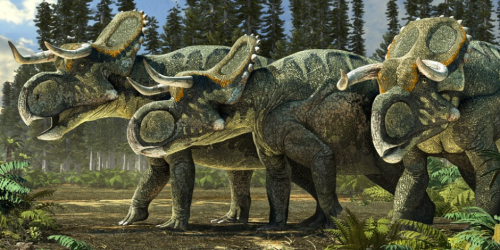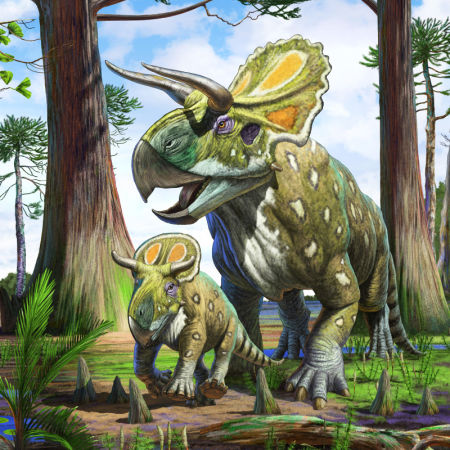Post by ornithopsis on Oct 15, 2015 21:20:52 GMT
Nasutoceratops titusi

Source: romangm.com/nasutoceratops-tittusi/, Román Garcia Mora
Name: Nasutoceratops
Name Meaning: Large-nosed horned-face
First Described: 2013
Described By: Sampson et al.
Classification: Dinosauria, Ornithischia, Genasauria, Neornithischia, Cerapoda, Marginocephalia, Ceratopsia, Neoceratopsia, Coronosauria, Ceratopsoidea, Ceratopsidae, Centrosaurinae
Nasutoceratops was a ceratopsian from the Campanian age of the Late Cretaceous, about 76 to 75.5 million years ago. It was found in the upper Kaiparowits Formation, within the Grand Staircas-Escalante National Monument, in southern Utah. It is one of the only two centrosaurine ceratopsians from the American southwest, along with Diabloceratops. It had the longest horns of any member of the Centrosaurine group; this is not, however, the group that contains Triceratops. The skull was about 1.5 meters long, and its body was about 4.8 meters long. Its nose was low and narrow, with an elongated base. Th osteoderms on the edge of the frill were not spikes but rather low crescents, unlike many Ceratopsidans. The curved horns were similar to that of modern cattle, spanning 40% of the skull length. It has been found with skin impressions, showing eight to 11 mm wide hexagonal scales surrounded by smaller, triangular scales.

Source: www.advocate-art.com/artist.rudolf-farkas, Rudolf Farkas
Nasutoceratops was a fairly basal member of the Centrosaurine group, meaning it did not evolve long after the Chasmosaurine group (that’s the one with Triceratops) diverged form the Centrosaurine group. It differed from most other Centrosaurines in retaining long brow horns and a short nose horn, a characteristic of those in the group on the southern side of Laramidia - a fascinating display of biogeography and divergence in a cladistic group. It lived near the western shore of the Western Interior Seaway, on an ancient floodplain with large channels and wetland peat swamps, ponds and lakes, bordered by highlands. It lived in a wet and humid climate, with a diverse and numerous variety of organisms, making it one of the best records of Late Cretaceous terrestrial life in the world. It lived alongside many other dinosaurs such as dromaeosaurids, Talos sampsoni, Ornithomimus velox, Albertosaurus, Teratophoneus, ankylosaurids, Parasaurolophus cyrtocristatus, Gryposaurus monumentensis, Utahceratops gettyi, Kosmoceratops richardsoni, and Hagryphus giganteus.
Source:
en.wikipedia.org/wiki/Nasutoceratops
www.prehistoric-wildlife.com/species/n/nasutoceratops.html
Shout out goes to theTorterra because he texted me in the middle of my work day saying “btw Nasutoceratops was on the PSAT” and I was like “Dafuq why didn’t my standardized tests include dinosaurs how is this fair.” So, yes, I’m capitlizing on a meme and doing another dinosaur, even though I have a biochem test tomorrow. I make FANTASTIC life choices.

Source: romangm.com/nasutoceratops-tittusi/, Román Garcia Mora
Name: Nasutoceratops
Name Meaning: Large-nosed horned-face
First Described: 2013
Described By: Sampson et al.
Classification: Dinosauria, Ornithischia, Genasauria, Neornithischia, Cerapoda, Marginocephalia, Ceratopsia, Neoceratopsia, Coronosauria, Ceratopsoidea, Ceratopsidae, Centrosaurinae
Nasutoceratops was a ceratopsian from the Campanian age of the Late Cretaceous, about 76 to 75.5 million years ago. It was found in the upper Kaiparowits Formation, within the Grand Staircas-Escalante National Monument, in southern Utah. It is one of the only two centrosaurine ceratopsians from the American southwest, along with Diabloceratops. It had the longest horns of any member of the Centrosaurine group; this is not, however, the group that contains Triceratops. The skull was about 1.5 meters long, and its body was about 4.8 meters long. Its nose was low and narrow, with an elongated base. Th osteoderms on the edge of the frill were not spikes but rather low crescents, unlike many Ceratopsidans. The curved horns were similar to that of modern cattle, spanning 40% of the skull length. It has been found with skin impressions, showing eight to 11 mm wide hexagonal scales surrounded by smaller, triangular scales.

Source: www.advocate-art.com/artist.rudolf-farkas, Rudolf Farkas
Nasutoceratops was a fairly basal member of the Centrosaurine group, meaning it did not evolve long after the Chasmosaurine group (that’s the one with Triceratops) diverged form the Centrosaurine group. It differed from most other Centrosaurines in retaining long brow horns and a short nose horn, a characteristic of those in the group on the southern side of Laramidia - a fascinating display of biogeography and divergence in a cladistic group. It lived near the western shore of the Western Interior Seaway, on an ancient floodplain with large channels and wetland peat swamps, ponds and lakes, bordered by highlands. It lived in a wet and humid climate, with a diverse and numerous variety of organisms, making it one of the best records of Late Cretaceous terrestrial life in the world. It lived alongside many other dinosaurs such as dromaeosaurids, Talos sampsoni, Ornithomimus velox, Albertosaurus, Teratophoneus, ankylosaurids, Parasaurolophus cyrtocristatus, Gryposaurus monumentensis, Utahceratops gettyi, Kosmoceratops richardsoni, and Hagryphus giganteus.
Source:
en.wikipedia.org/wiki/Nasutoceratops
www.prehistoric-wildlife.com/species/n/nasutoceratops.html
Shout out goes to theTorterra because he texted me in the middle of my work day saying “btw Nasutoceratops was on the PSAT” and I was like “Dafuq why didn’t my standardized tests include dinosaurs how is this fair.” So, yes, I’m capitlizing on a meme and doing another dinosaur, even though I have a biochem test tomorrow. I make FANTASTIC life choices.



